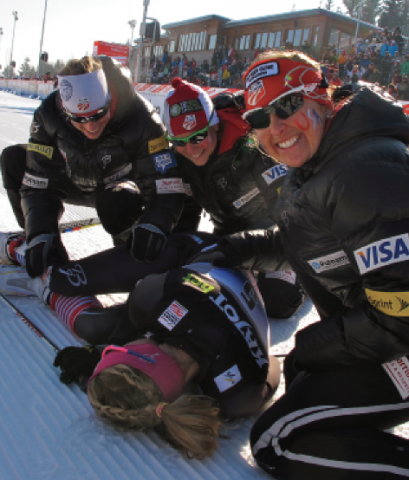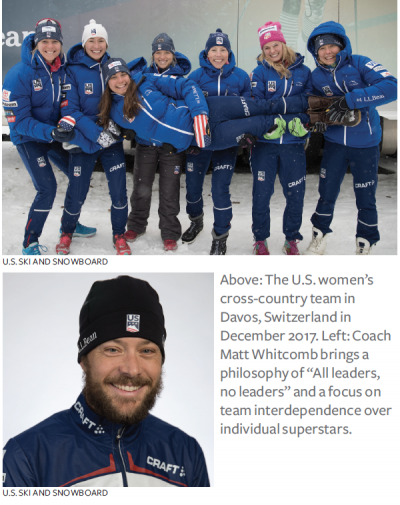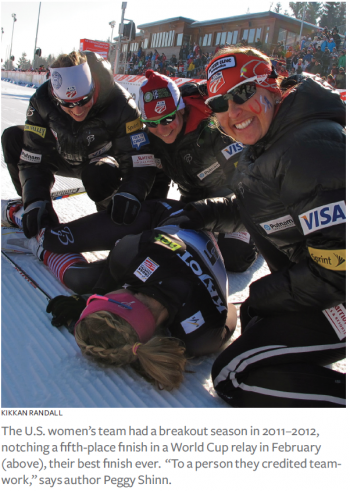
U.S. Skiing could learn a lot from the success formula within its own women’s cross-country team. By Edith Thys Morgan
The FIRST, EVER, cross country gold medal for the U.S.!” Those words, screamed by commentators in joyful disbelief, capped off one of the most memorable moments of the 2018 Winter Olympics. When Americans Kikkan Randall and Jessie Diggins won the team freestyle event, it was not only a triumph of persistence and hard work, but also the ultimate validation of the power of team.
 The U.S. victory was particularly interesting against the backdrop of Norway’s record 39 Olympic medals in Pyeongchang, accomplished with a mere 109 athletes (Team USA won 23 medals with 242 athletes). The buzzwords behind Norway’s success—culture and team—echo the values portrayed in World Class, a new book by Vermont author Peggy Shinn. They also stand in stark contrast to the dynamics that have evolved on the U.S. Alpine Ski Team in the past decade, where individual superstars have assembled private teams that cater exclusively to their needs. U.S. Alpine success in Pyeongchang was underwhelming, and U.S. Skiing could learn much from the success formula within its own organization. Through extensive research and interviews, Shinn recounts the history of the U.S. Nordic Ski Team, and details the team’s journey from the low point in 2005–2006—when the U.S. did not even name a women’s Nordic ski team for the World Cup season—to the spring of 2017, when a full team of medal-ready women stood poised to make history.
The U.S. victory was particularly interesting against the backdrop of Norway’s record 39 Olympic medals in Pyeongchang, accomplished with a mere 109 athletes (Team USA won 23 medals with 242 athletes). The buzzwords behind Norway’s success—culture and team—echo the values portrayed in World Class, a new book by Vermont author Peggy Shinn. They also stand in stark contrast to the dynamics that have evolved on the U.S. Alpine Ski Team in the past decade, where individual superstars have assembled private teams that cater exclusively to their needs. U.S. Alpine success in Pyeongchang was underwhelming, and U.S. Skiing could learn much from the success formula within its own organization. Through extensive research and interviews, Shinn recounts the history of the U.S. Nordic Ski Team, and details the team’s journey from the low point in 2005–2006—when the U.S. did not even name a women’s Nordic ski team for the World Cup season—to the spring of 2017, when a full team of medal-ready women stood poised to make history.
Shinn got her inspiration while watching the U.S. Women’s Nordic Team during its breakout season of 2011–2012. The women had just notched their best World Cup relay finish ever, fifth place, and they had done it without their longtime superstar, Kikkan Randall, who was ill that day. When Shinn asked the women about their success, she writes: “They did not credit their individual strengths…to a person they credited teamwork.” As a former competitor in many sports, and a journalist covering Olympic sports for Team USA.org, Shinn was intrigued. She set about understanding the power of team, and showing it work through the lens of a sport that is known for being solitary, brutally demanding, chronically underfunded and not particularly fun.
After that breakthrough season, the team would go on to win eight medals in three World Championships in the next five years, and they would accomplish this decked out in patriotically striped goofy socks, pink-streaked hair, glittery face paint and huge smiles. The medals validated their own individual journeys of hard work, optimism and uncompromising standards, but also their unwavering commitment to each other. As Shinn writes of the Nordic team: “They have everything from the transformational leader, to the coach who connects with his athletes, to the agreeable, conscientious energizers who comprise the team.”
THE LEADER
The transformational leader is Kikkan Randall, an Alaskan who graduated from high school in 2001 with the nickname “Kikkanimal” and a ten-year plan to win an Olympic medal. She soon became a star on the U.S. Ski Team. Like top U.S. Nordic women before her, she did this as a solo star, traveling and training with the U.S. men or with women from other countries. Unlike many stars, Randall is also the consummate teammate and leader, who hordes neither control nor attention, and is “as happy for her teammates’ successes as she [is] for her own.” In the spring of 2006, inspired by the steady and remarkable ascent of the Canadian Nordic team, Randall lobbied hard for a women’s team, with teammates and a dedicated coach. Coach Pete Vordenberg demanded a $1 million budget for the Nordic Team and U.S. Skiing president Bill Marolt agreed, putting the money towards coaches and a young development team.
THE COACH
Matt Whitcomb, who had built a Nordic program at Burke Mountain Academy, joined the U.S. Cross Country Ski Team in 2006 and was named head women’s coach in 2012. He brought the structure, discipline, patience and inclusiveness to turn Randall’s team vision into a reality. Friendly and approachable, his positive coaching style—gleaned from his own coaches growing up in the Berkshire Mountains of western Massachusetts—reinforced what athletes did right, versus dwelling on what they did wrong. He also adopted Burke’s motto of, “All leaders, no leaders.” Whitcomb explains that only four of the seven podium-level women can be on a relay team. “But it’s the three who aren’t selected who hold the key in their hands. The tone that they set—from the moment they find out they are not selected for the relay—can either add or subtract from the team atmosphere.” That realization of interdependence is a cornerstone of how the team viewed and treated each other.
THE ATHLETES
In addition to these remarkable leaders, World Class is about the entire team that buoyed, pushed and lifted each other to greater heights. This includes Liz Stephen, Holly Brooks, Jessie Diggins, Ida Sargent, Sadie Bjornsen, Sophie Caldwell and Rosie Brennan—women

who range from young phenoms to college athletes to working adults, and come from points all across the country—as well as the many women before them who steadily emboldened Team USA. They did so by their performances but also by cheering wildly from the sidelines, being patient with rookie moves and costly mistakes, or embracing rituals like group karaoke and writing personalized Secret Santa poems. Working hard together, inside a supportive, communicative, and optimistic environment, they became a high-performance engine.
THE ATTITUDE, AND LACK THEREOF
World Class is also about cooperation for a common cause, and how a sport becomes a family. The decades it takes to fully develop talent, combined with notoriously shoestring budgets, mean the U.S. Nordic Ski Team must rely heavily on privately funded, post high school feeder programs. These include the Craftsbury Green Racing Project and the Stratton Mountain School T2 in Vermont, along with Alaska Pacific University and top NCAA schools that fund development through their ski teams. The National Nordic Foundation—a nonprofit grassroots organization—also lends support to up-and-coming Nordic skiers. Success depends on cooperation and communication between all these organizations and the national federation. Here, too, the Alpine team can take notes on how to fully embrace and optimize development resources.
World Class captures many pivotal moments, be they inspirational success, resilience after failure or the necessary readjustments when the magic seemed to be gone, and tells a story that goes well beyond the success of one team. As Sadie Bjornsen said after her first individual World Cup podium: “…We are dreamers. But we are also believers. It’s crazy how much confidence you can get from a teammate’s success if you allow yourself to stand beside them.”
World Class: The Making of the U.S. Women’s Cross-Country Ski Team by Peggy Shinn. Published by ForeEdge (2018); 248 pages, 38 color illustrations; $19.95 paperback, $14.99 e-book (www.ForeEdgeBooks.com).
